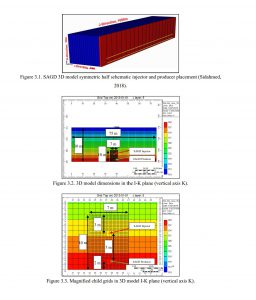Workflow for Sand Control Testing of Injection Wells in Steam Assisted Gravity Drainage (SAGD)
本研究旨在解决SAGD注入井砂控测试(SRT)中的生产工程问题。业界常见的做法是通过部署独立筛管(SAS)来防止沙粒进入井筒。SAS包括开缝衬管(SL)、缠丝筛管(WWS)和冲孔筛管(PS)等。本研究为SAGD注入井的SL设计开发了一种系统方法,尽管解决方案特别针对SAGD注入井,但相同或类似的方法也可以应用于其他注入井或生产井。SRT研究以SAGD注入井返排为示范,比较所提出方法与先前技术的能力,先前技术有时依赖于假设或无效假设,因为缺乏必要的现场数据来执行此类研究。通常,现场数据是保密的,几乎不可能获得,尤其是在注入井返排这样的危险场景中。
CMG软件应用情况:
在本研究中,使用CMG STARS模块预测SAGD注入井返排,这是从储层工程角度了解可能的砂粒释放的唯一途径。此外,将CMG模型与天然气流动相关性耦合,通过交互式内部开发的Excel程序简化生产系统变化的修改,从而将计算时间从约20小时减少到不到1小时。通过使用基于对称性的2D模型而非3D模型,显著减少了计算时间。考虑热力学平衡变化极大地改变了对问题的理解,避免了过去使用的不准确假设。
作者单位:
- 阿尔伯塔大学土木与环境工程系石油工程硕士
ABSTRACT
This research aims at tackling a specific production engineering problem in sand retention testing (SRT). One common practice of operational oil companies is to prevent sanding by deploying standalone screens (SAS). SAS consists of slotted liners (SL), wire wrap screens (WWS), and punched screens (PS), among others. A systematic methodology was developed for SL design using the SRT for steam-assisted gravity drainage (SAGD) injectors. Although the solution is particular for the SAGD injector, the same or similar methodology can also be applied for any other injection or even production well. SRT investigation for SAGD injector flowback was considered as a demonstration for the capability of the proposed methodology in comparison to previous techniques. The previous techniques sometimes rely on hypothetical or invalid assumptions due to the lack of necessary field data to perform such a study. Often, field data are confidential and nearly impossible to obtain for a hazardous scenario like a thermal injector flowback.
The proposed methodology consists of three fronts. The first front is to estimate the laboratory testing variables or operational parameters based on case-specific data and reservoir simulations to assess the flowback. The simulation accounts for the unique reservoir characteristics that change from one field to another. The STARS module of the Computer Modelling Group (CMG) simulator was used to predict the consequences of SAGD injector flowback, which is the only possible way of sanding from a reservoir engineering viewpoint. Moreover, one of the natural gas flow correlations was coupled to the CMG model to ease the modification of production system variability by an interactive, in-house developed, excel program. The coupling reduces the computational-time from about 20 hours to less than 1 hour. The computational-time reduction was due to using a 2D-model, based on symmetry, instead of the 3D-model. Accounting for thermodynamic equilibrium changes the understanding of the problem drastically by avoiding inaccurate assumptions used in the past.
The second front is to develop a new SRT set-up specialized for SAGD injector flowback laboratory testing and maintain a cost-effective research budget. Intensive testing was performed to troubleshoot the associated problems with high-velocity gas flow. The final front was to verify the performance and efficiency of the developed testing set-up by conducting six tests. Furthermore, more representative reproducibility criteria were proposed to ensure testing repeatability.
SRT results show that the current industry practices for SL selection, which rely upon field experience or rules of thumb, are not conservative as previous researches claim. Eventually, this research should be considered as a single-step only in SRT for SAGD injector flowback, and necessary methodology enhancements and facility upgrades should be investigated in future work.


